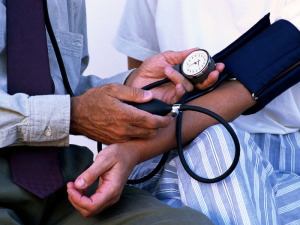By: Dr. Geoffrey Modest
Circulation had an article on the prevalence of orthostatic hypotension in Ireland (see doi:10.1161/CIRCULATIONAHA.114.009831). This study involved 4475 community-based people over age 50 from a nationally representative cohort study (TILDA — The Irish Longitudinal Study on Ageing — that’s how they spell “aging”…), recording blood pressure and pulse response to standing. They looked at initial orthostatic hypotension, defined as a BP decrease of >40 mmHg systolic or >20 mmHg diastolic within 15 seconds of standing and associated with symptoms of cerebral hypoperfusion, and typical orthostatic hypotension, defines as a BP decrease of >20 mmHg in systolic or >10 mmHg in systolic after 3 minutes of standing.
Findings:
–Cohort baseline characteristics: average age 62.8, 51.8% female, 19% smokers, 7.5% diabetes, 34.5% hypertensive, total of <11% with any cardiovascular history — so pretty healthy
–Initial orthostatic hypotension in 32.9% of those >50yo, no difference by age or gender
–Typical orthostatic hypotension in 6.9% overall, increasing from 4.2% in 50 yo to 18.5% in those >80yo
–Prevalence of failure to return to baseline blood pressure after standing 40 seconds increased with age: from 9.1% in 50 yo to 41.2% in those >80yo
So, a few points.
- The pathophysiology and epidemiology of initial orthostatic hypotension is somewhat different from the typical orthostatic hypotension. With initial orthostatic hypotension, there is a rapid temporal mismatch between cardiac output and vascular resistance. This typically happens in thin young people (who need to dangle their legs prior to getting out of bed, for example) and those on a-blockers (including reports with tamsulosin for BPH). The typical orthostatic hypotension results from standing, pooling of blood in the legs, decreased venous return, which usually triggers a baroreceptor reflex inducing vasoconstriction (so the the usual change is a decrease of about 5 mmHg systolic and a slight increase in diastolic, which rapidly reverses with rapid vasoconstriction). but without this vasoconstriction, there is subsequent decrease in cardiac output and hypotension. This tends to happen in older people who have diminished baroreceptor responsiveness, and in those with hypovolemia, on aggressive diuretics, tricyclic antidepressants, etc.
- I don’t want to overinterpret this study. The population studied was racially and ethnically pretty uniform. There was no information on whether there was a difference if they had underlying hypertension or what medications they were taking. and there are no data on whether the typical orthostatic hypotension was symptomatic. And the limited data available do not all point to asymptomatic hypotension as a cause of falls, for example. BUT, to me, these numbers are very impressive. I do typically check orthostatics on my elderly patients and very often do find marked hypotension on standing, sometimes symptomatic and sometimes not. when the patient is symptomatic (either by history at home, eg when standing, or in the office), I do not hesitate to back off on BP meds (or if they are not on them, I sometimes need to use fludrocortisone and high salt diets to raise the blood pressure). in asymptomatic patients, the decision is harder. In general, I am pretty concerned that they may have an even more exaggerated hypotensive orthostatic response if they are a little dehydrated (hot summer day), or don’t drink their usual amounts of fluids, or even postprandially, when blood pressure tends to be lower. It is also impressive that symptomatic initial orthostatic hypotension happens in about 1/3 of the patients over 50 yo. So, seems reasonable to ask specifically about that, as well as falls…
So, my approach is that if the blood pressure really drops on standing (eg a systolic less than 120), I do back off on blood pressure meds even if the patient is asymptomatic. Given the lack of data in the elderly that a lower systolic is beneficial (perhaps because the studies did look at lower blood pressures, leading JNC8 to suggest a target of 150/90), seems like the better part of valor to back off on blood pressure meds.